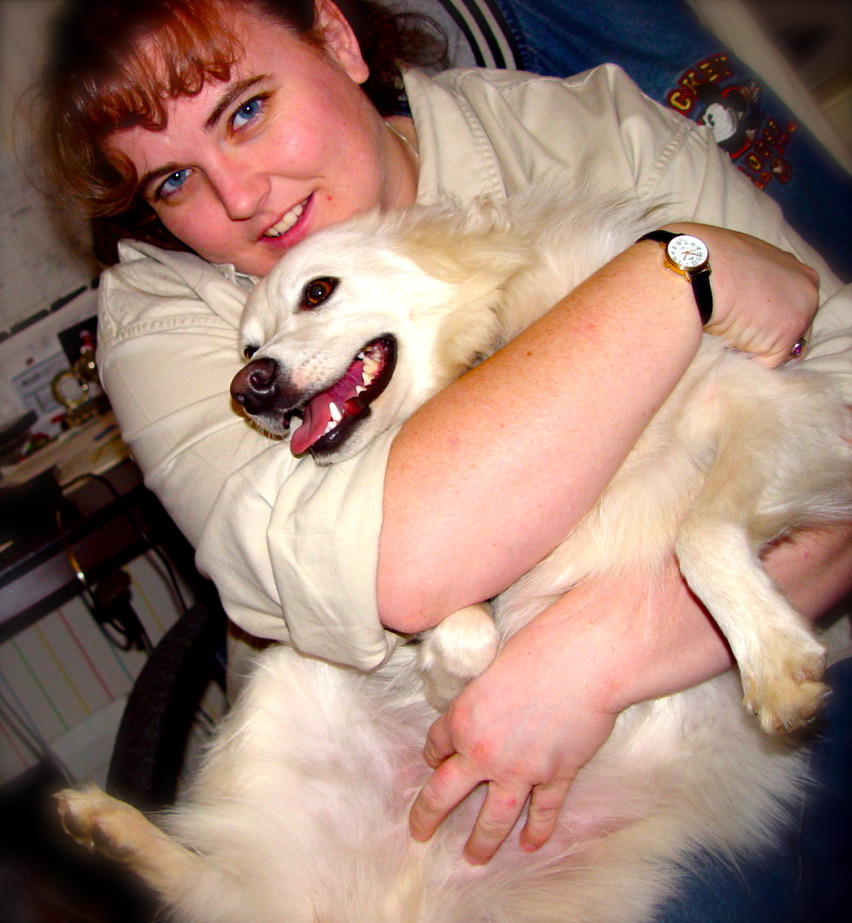By Amanda J. McKitterick (10 July 2024)

(3 Days, 3 Weeks, 3 Months)
Adopting a New Dog and the 3-3-3 Rule
3 Days to decompress
3 Weeks to learn your routine.
3 months to start to feel at home and secure, and to begin to build trust and a true bond.
Are you considering or have you recently brought home a new furry friend? Sometimes, our vision of this new addition doesn’t match up with reality. This happened to me when I was in my early twenties…
(*cue blurring out visual to the sounds of Wayne and Garth, if you know, you’re cool!)
I was fairly fresh out of the military, had settled into a great new job, had my own place… and a bad influence for a boyfriend. We were out messing around at the mall (before I knew about puppy mills and pet stores) and, of course, had to visit those cute fuzzy little pups at the pet store. And that’s when it happened. My heart was ripped from my chest by a small fluffy white ball of fur. I tried to walk away and think sensibly… and I would like to lay the blame on my boyfriend for talking me into it, but the truth is, she instantly had my heart.
For only $35 a month, she could be mine! I was so excited, I didn’t even ask the actual cost I would be paying. So much for logical thinking and being the responsible one. To make up for my obvious impulsivity in getting her, I bought a book about American Eskimo Dogs. (Yes, this story predates Google!) I didn’t know anything about her breed after all, and she wasn’t anything like the mixed pups we had growing up.
The day we got to take her home, the guy at the shop said he had been calling her Snow White… and being an absolute Disney nerd, you know I kept that name! Often, as humans, we fall in love with our pets so quickly that we forget it isn’t as instant for them. Your new pet may have just left their mom and siblings for the first time or may have spent some time in a shelter (a puppy mill) or rescue. I learned years later what kinds of atrocities that environment could entail. Whatever the case, it’s always big to them and the transition can be scary.
It is so important that we manage our expectations. Moving in with a new family is stressful, no matter how kind they are. Have patience with your pup and yourself as you all adjust to new routines and lifestyles.
For the first three days, your new pup will need to decompress. Give them plenty of space away from people and other pets. They need time to acclimate. Let them initiate interactions with family members. They may show signs of fear, nervousness, or confusion and may be hesitant to drink, eat, or play at first. This is normal.
As a young, dumb, and new pet parent… I didn’t do any of that. We struggled with potty training at first, but thankfully, Eskies are incredibly smart, so I lucked out as she picked up what I was trying to do.
We hadn’t even bothered to find out if she and my boyfriend’s dog, who had recently been yanked from the comfort of her home with his mom and brought to my apartment unceremoniously, even liked each other. To say his chihuahua was used to getting her way is an understatement. Needless to say, mistakes were made.
Despite providing her with a mountain of toys, she had full and unsupervised access to my apartment all day while we were at work. Not long after getting her put a 2×4 foot hole in my carpet by yanking out all the little fibers… (Oh! Wo satisfying) Another day, she single-handedly ate my brand new (still paying it off on my credit card) $1000+ couch. How such a small puppy (under 20 lbs) could cause so much havoc was a mystery to me?! This did not make for a great first impression only a few weeks into our bonding and relationship building. The issues were stress, boredom, lack of structure, and too much freedom.
We can unpack some of these other issues later. For now… back to the 3-3-3 rule.

Limit their access to your home using an exercise pen, crates, or gates until they can be trusted with more freedom. (Doh! The more you know) Granting instant full access could lead to issues with potty training or unwanted damages. (Dang… sounding familiar?!) Dogs don’t understand the rules; it’s up to us, the humans, to teach them. (Hard lesson learned there!)
During the first three weeks, gradually introduce them to family and guests. Start familiarizing them with their new environment, sights, sounds, and smells. Consider starting a training program or class. Be mindful of their comfort level in different situations.
By the end of the three weeks, your dog should feel more comfortable with their new home and routines. Establishing a regular routine helps build their confidence and makes them feel safe and secure. Remember, every dog is unique, so some may take longer to adjust than others.
Noting our mistakes of giving her too much freedom, we got a kennel and used it during the day. I worked only a mile away so I would come home on my lunch break to let her out and play. We used the kennel to cover the carpet, blocking her temptation to continue her “hole” project. I accepted that I wasn’t getting that deposit back!
Despite the re-stuffing and sewing of my couch, it always looked like it belonged in the home of Dr. Frankenstein. Thankfully, it was still very comfortable and was well used for several years to come.
Over the next couple of months, we did get better at her routine and started training her via books, varied advice from co-workers and friends, and stuff found on the internet. But the routine and the simple use of the crate were such huge game-changers for us. Her stress decreased, and so did the destruction of my apartment.
By the 3 month mark, we were in a much better place and bonding well. I wish I could say those were the only mistakes I’d made, but I was in my early 20s… so you know it would be a lie!
Later, Snow White and I got rid of the boyfriend and the sassy chihuahua and started a new chapter together. She was my little ‘Ride or Die’ girl for the next 16 years, so we have some stories to share! She was no doubt one of my biggest learning experiences and reasons I eventually found my way to becoming a professional trainer.
What I want you to remember when you get a new dog or pup… or any pet really… is to be patient and understanding of what they may be going or have gone through before they came into your life. Understand that stress can cause some very unwanted behaviors and we often falsely attribute those behaviors and actions. Stress in an animal can manifest in many ways.
Continue to positively reinforce behaviors you like to build confidence and establish good routines. Be patient with your new dog and keep providing them with plenty of love, play, structure, and routine. It will make a world of difference.



